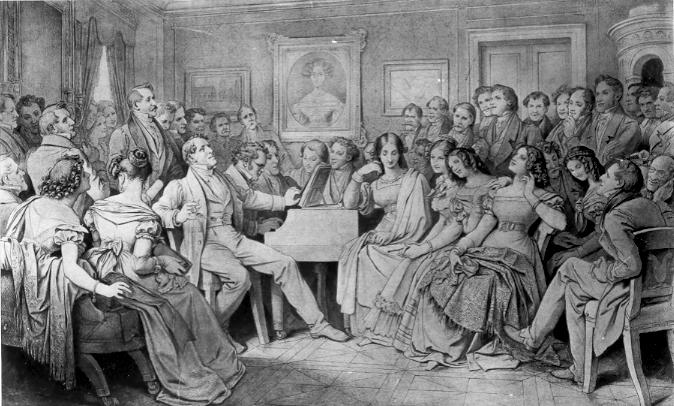Schubert, Impromptu in B-flat, Op. 142
 Franz Schubert (1797-1828) produced two sets of four impromptus in 1827. An impromptu, loosely translated as “offhand,” fit the times as a character piece suitable for the aristocratic salons. The salons—gatherings in private homes—had become the critical source of patronage in the years after the French Revolution. In this famous drawing of Moritz von Schwind entitled “Schubertiade,” we see Schubert seated at the piano in an imagined salon.
Franz Schubert (1797-1828) produced two sets of four impromptus in 1827. An impromptu, loosely translated as “offhand,” fit the times as a character piece suitable for the aristocratic salons. The salons—gatherings in private homes—had become the critical source of patronage in the years after the French Revolution. In this famous drawing of Moritz von Schwind entitled “Schubertiade,” we see Schubert seated at the piano in an imagined salon.
Schubert is known as one of the great melodists. This Impromptu, in the form of a theme and variations, offers a good example. The theme is stated at the beginning and followed by 5 variations. Each variation takes the listener farther afield but retains enough of the theme that you should not have much difficulty following it. Each variation has its own separate character.
A set of variations would typically include one in the parallel minor key, and Schubert follows that convention in the third variation. But instead of returning to the main key of B-flat, he pitches the fourth variation in G-flat. I think it’s this kind of harmonic richness, as much as the melodies, that draws me to Schubert. Of course, the two work hand in hand. When I was teaching music theory to sophomores who had started studying more advanced chromatic harmony, Schubert often provided the best examples. Not the long and pervasive use of chromaticism that would come later, Schubert’s chromaticism occurs instead in short phrases and turns of harmony—within a more classical context. Always sounding natural and effortless, they fit perfectly with the text painting of Schubert’s Lieder (songs). And that partly explains why his 600 songs rank as his greatest achievement. That, and the melodies.
This Impromptu has the same kind of lyricism and shows Schubert’s command of the character piece as well.



